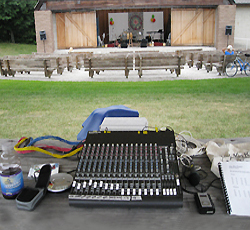
Musicians want clear directions from the sound mixer. For example, “Bass guitar: play for a minute and nod when it’s loud enough.” “Lead singer, please get closer to your mic.” “Mr. guitar, please move your mic a little more toward the neck.”
Never allow feedback during a sound check! Not only is it annoying and painful, it can damage hearing and cause tinnitus. Some studio engineers, placed in a live situation without prior live sound experience, can inadvertently create feedback when they turn a knob too quickly, or un-mute a channel when its gain is way up. They are used to turning knobs with no harmful consequences. Slow and deliberate is the key.
Here’s a suggested order of events in a typical sound check:
1. With faders and monitor sends set very low, set the gain trim for each instrument/vocal.
2. With faders up, set the monitor level for musician #1.
3. Set preliminary EQ for musician #1.
4. Repeat steps 2-3 for musician #2, and so on.
5. Set up a drum submix and vocal submix if applicable.
6. Ask the entire band to play, and set up a house mix.
7. Touch up the monitor mixes as requested by the band members.
We’ll go over each step. Let’s say the lines are checked and the band is on stage.
Set Gain Trims
First, set the faders and monitor sends very low to prevent feedback as you are adjusting the gain trims.
You might say to the band, “Okay we’re ready for the sound check. I’m just setting levels now, not monitors.”
Ask musician #1 to play or sing as loud as he/she will during the performance. Slowly turn up the gain trim until clipping occurs, then back off about 10 dB to create some headroom. (There are other methods). Repeat for each musician.
Important: Remind the musicians not to change their volume-control settings between the soundcheck and the performance.
Set Monitor Levels
Turn up the faders to design center (but watch out for feedback). Use full-volume house levels if possible so the monitors don’t need to be turned up so much.
Ask musician #1 to play. Slowly bring up that channel’s monitor send until the musician says the level is okay.
Say something like, “Terry, play your bass and let me know when it’s loud enough for you.”
Of course, some musicians do not want to be heard in the monitor loudspeakers.
Set EQ
Now ask musician #1 to play or sing non-stop as you set preliminary EQ for that channel. Make sure it sounds reasonably accurate.
If an acoustic guitar is boom-y, move the mic away from the sound hole or turn down the low-frequency EQ.
If an acoustic guitar pickup is too bright or electric sounding, turn down 2 kHz and/or 12 kHz. If you hear vocal pops, switch in a high-pass filter at 100 Hz or so. It’s a good idea to high-pass everything except maybe the bass, kick and synth.
Set the monitor level and EQ for each musician. A typical checking order is drums (each part of the kit), bass, backup instruments, lead instruments, and vocals.
Do The House Mix
Once all the instruments and vocals are set individually, ask the drummer (if any) to play. Set up a drum sub-mix.
Then ask the singers to perform at full volume and set up a vocal sub-mix.
